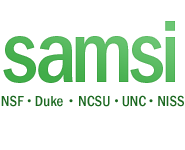Complex Networks: Pedestrian Traffic Flow - February 14-16, 2011
Workshop Information
This workshop will be held at SAMSI.
Human crowds and pedestrian groups exhibit complex and coordinated spatio-temporal patterns such as the spontaneous organization of pedestrian flows into lines and the oscillations of fluxes at gates or intersections. Understanding these phenomena requires a deeper knowledge of the laws governing the interactions of individuals with both themselves and their environment. Although a number of experiments can be found in the literature, the available data does not lend itself well to systematic study. The lack of completeness and varying quality of available experimental data make it nearly impossible to identify the fundamental principles underlying pedestrian behavior. Motion capturing techniques have become available in the recent years and permit more complex experiments, yielding comprehensive recordings of individual positions. Such experiments generate a formidable amount of data. Mathematical modeling and numerical simulation can facilitate the extraction of information from such data, helping to identify relevant observables by which a set of biological hypotheses can be validated. Such a dialectic use of experiment and simulation results in the ability to extract from traffic data an ensemble of behavioral rules, which can then be inserted into individual (agent)-based simulation models. For crowds involving several thousand (or more) individuals, continuum fluid-mechanical-like models are attractive, from both the computational and theoretical viewpoints. Deriving these models from the individual behavior by means of statistical physics guarantees their biological relevance and opens the way to qualitative analysis and understanding of many observed emerging phenomena in crowds.
The workshop is aimed at bringing together experts from different fields with the main objective to systematically develop and analyze a hierarchy of pedestrian traffic models. The studied hierarchy of models consists of three levels: (i) Microscopic description, (ii) Mesoscopic description and (iii) Macroscopic PDE description. The microscopic description is similar to spin-flip models, an interacting system of cellular automata. All modeling assumptions are only made at the microscopic level. Mesoscopic and macroscopic models are rigorously derived through appropriate averaging and limiting procedures; no ad-hoc assumptions on the density and velocity of the flow are used in the derivation. One of the main goals of the workshop is to naturally link three levels of description, allowing for a detailed analysis of how various terms in the macroscopic PDE model are affected by the microscopic assumptions.
February 14 ‐ Traffic Flow and Other Mathematical Models of Collective Behavior
09:00-09:30 Coffee
09:30-10:15 Jian-Guo Liu: Dynamics of Orientational Alignment and Phase Transition
10:30-11:15 Vladislav Panferov: Continuum description for systems of selfpropelled particles used in modeling fish migration
11:30‐12:15 Anthony Polizzi: Modern freeway traffic flow models
12:30‐02:00 Lunch
02:00‐03:30 “Modeling Traffic Flow” group report and discussion on connection between traffic and pedestrian flow models led by Ilya Timofeyev
04:00‐05:00 Pierre Degond: Current challenges in pedestrian dynamics and crowd modeling
February 15
09:00-09:30 Coffee
09:30-10:15 Alexander Kurganov: Numerical methods for traffic and pedestrian flow models
10:30‐11:15 Sebastien Motsch: A traffic model for pedestrians and its comparison with experimental data
11:30‐12:30 Discussion on pedestrian flow models led by Pierre Degond and Ilya Timofeyev
12:30‐02:00 Lunch
02:00‐05:00 Open problem session and work in small groups
February 16
09:00-09:30 Coffee
09:30‐12:30 Work in small groups
12:30‐02:00 Lunch
